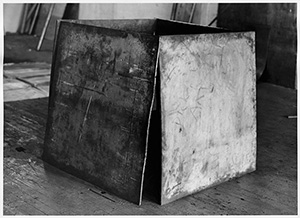
Weight and balance
“ For me weight is an essential value; it’s not that it’s more attractive than lightness, but I simply know more about the heavy than about the light and therefore I have more things to say about it, more to say about the balance of weight, the reduction of weight, the addition and subtraction of weight, the concentration of weight, the manipulation of weight, the retention of weight”(1).
One–Ton Prop (House of Cards), 1969
Lead antimony. Four plates, each: 121,9 x 121,9 cm
Museum of Modern Art, New York. Gift of the Grinstein family
Photo: Peter Moore
Introduction
Notwithstanding their great weight and size, the plates that form Richard Serra’s (San Francisco, USA 1939) sculptures aren’t permanently anchored to the floor, but held in balance. The artist calculates in advance and in great detail the shape and weight that the plates should have so that they can stand by themselves.
Serra feels a profound fascination for weight: with his works he searches to underline the psychological and spiritual effects that weight has in our lives. He feels more related to “heaviness” than to “lightness”. For Serra, weight is a physical condition to which we are all condemned to by the force of gravity. In his works heavy steel or lead plates are free standing without any other support. This causes his works to be full of tension, like in One–Ton Prop (House of Cards), 1969, where four lead plates are vertically sustained by their own weight by having them lean against each other, like in a house of cards.
In the last thirty five years, Serra has used primarily steel to make his sculptures, allowing their scale increase considerably. The scale, weight and height of the installation titled The Matter of Time are monumental. The lightest piece weights 44 tons and the heaviest 276 tons. All of them are more than four metres tall and around five centimeters thick. The artist does a previous exhaustive study of the structural principles of the material in relationship with the weight and mass to be able to achieve an extreme tension in his works. These works situate us in an ambiguous space, where weight becomes light. The enormous mass, despite its weight, becomes airy. Serra transforms a steel plate into a floating object by folding it in particular ways. Weight and balance, gravity and grace provoke opposite reactions and feelings in the spirit of the viewer allowing multiple reactions to the work The artist has arranged the pieces of The Matter of Time in such a way that the viewer is able to move through them and through the space surrounding them, so as to maximize the visual impact of their physical presence.
Serra, in his study of weight and balance, uses the observation of the human body as a vivid and moving example of tension. In this way, his pieces can be compared to a dancer, who, through his dance, defies gravity through movement and balance.
1 Richard Serra. Exhibition Catalogue. Serra. January 28–March 23, Museo Nacional Reina Sofía, Madrid, 1992, p.9.
Preguntas
Name everyday objects that are heavy and others that are light. What sensations do heavy objects cause you? And the light ones? Name heavy and light materials. How can a heavy material turn into a light one? And vice versa?
Serra affirms that he feels closer to “heavyness” than to “lightness”, what do you think he means? To understand his preference you can read the quote that appears at the beginning of this folder. Which preference–heaviness or lightness– do you identify with more?
Show your students an image of the work One–Ton Prop (House of Cards) and ask them: How would you feel if you were close to this piece? Would it provoke the same effect on you if it was made out of a different material? In his works, Serra doesn’t use glue nor nails…how do you think that this piece can stand by itself? Why doesn’t the artist use anything to fix it to the floor? Serra titles this work One–Ton Prop (House of Cards). What does the title of the work suggest to you? Why do you think it has a double title?
The size of things affects our perception of them. How does the size of a sculpture affect our way of looking at it? Imagine Serra’s sculptures in a much smaller scale: how would your perception of them change? Why do you think Serra chose to create them in such a large scale?
Why do you think that Serra pays attention to dancers to study issues of weight and balance? What relationship can there be between a sculpture and a dancer?
